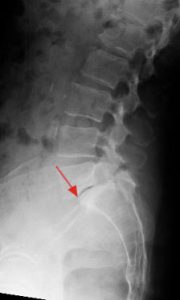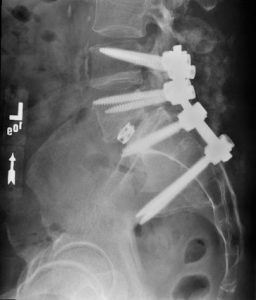Houston Scoliosis and Spine Institute

Spondylolisthesis
What is Spondylolisthesis?
Spondylolisthesis is a condition in which a vertebra in the spine slips forward over the vertebra below. The slip can change the spine’s alignment and balance, and can also result in compression of nerves in the spine. While this condition is not always painful, it can cause severe pain, sometimes even causing pain that shoots down the legs.
Spondylolisthesis usually occurs in the lumbar spine, or lower back area, most often involving the L4 and L5 vertebrae.
Types of Spondylolisthesis
There are two types of spondylolisthesis: degenerative and isthmic.
Degenerative Spondylolisthesis
Degenerative spondylolisthesis is most likely to occur in older patients, most commonly in women over the age of 60. It is caused by degenerative changes caused by wear and tear on the body. As the joints between the vertebrae weaken, the upper vertebra slips forward over the lower vertebra, resulting in a spondylolisthesis. Degenerative spondylolisthesis may be accompanied by spinal stenosis, nerve compression, and sharp pains.

Xray showing spondylolisthesis
Isthmic Spondylolisthesis
The second and most common form of spondylolisthesis is isthmic spondylolisthesis. This type is caused by either a genetic bone defect or a fracture of the pars interarticularis. The pars is a small boney section of the vertebra. If the pars did not form properly during the growth years, or if it breaks due to an injury, then the vertebra can slip forward. This type of spondylolisthesis affects almost four percent of the population.
Even in cases where isthmic spondylolisthesis is caused by a genetic defect in the pars, this can be made worse by physical stresses. Stooping, twisting, and lifting heavy objects can lead to small fractures. This is one reason why athletes such as gymnasts, weight lifters, football players have a high risk factor of spondylolisthesis.
Isthmic spondylolisthesis may appear when the patient is as young as eight years of age, as growth spurts reveal abnormalities in the spine. It may not be noticeable until later in life, when normal wear and tear, an injury, or a fall takes its toll on an already-weak vertebral structure.
Spondylolisthesis Symptoms
A common symptom of spondylolisthesis is sharp, radiating pain that begins in the lower back and shoots down the legs. This can be a constant pain or one that only occurs after exercise. Other symptoms include muscle spasms, weakness in the legs, tight hamstrings, and/or a limp.
More severe symptoms include neurological damage, swayback, and a protruding abdomen. A patient may also have a shortened torso due to this spinal condition.
Diagnosis of Spondylolisthesis
An accurate diagnosis of spondylolisthesis can be harder to obtain than for other back conditions such as scoliosis or kyphosis, where the spinal deformity can be more clearly seen.
The doctor will perform a physical examination to test the patient’s range of motion, reflexes, and balance. The doctor will also look for signs of muscle weakness.
The doctor will order a number of diagnostic tests. A set of x-rays will be first on the list, as they can identify a spondylolisthesis and also help to rule out other problems. An MRI or a CT scan may be ordered, to provide a three-dimensional picture of the spine and the spondylolisthesis. A myelogram may be used to help identify the extent to which any nerves have been compressed on pinched.
Grades of Spondylolisthesis
If you have a spondylolisthesis, you may hear your doctor referring to the grade of the slip. Many doctors use the Meyerding Grading System to describe the severity of spondylolisthesis:
Grade 1: Up to 25% of the vertebral body has slipped forwards over the vertebra below.
Grade 2: Up to 50% of the vertebral body has slipped forwards over the vertebra below.
Grade 3: Up to 75% of the vertebral body has slipped forwards over the vertebra below.
Grade 4: The entire vertebral body has slipped forwards over the vertebra below.
Grade 5: The upper vertebra has slipped 100 percent off of the lower vertebra (also known as spondyloptosis).
Non-Operative Treatment of Spondylolisthesis
If a pars fracture is identified before it causes spondylolisthesis, it is known as spondylolysis. At this stage, a brace may be worn to prevent slippage. Physical therapy, modifications to the patient’s activity, and anti-inflammatory medication may be enough to manage the problem. Once the pain of the fracture is reduced, the doctor may recommend that his or her patient begin an exercise program to strengthen the core muscles in order to support the spine. This exercise plan can include pilates or yoga.
Additionally, a grade I or II slippage (anything less than 50 percent) that does not result in debilitating pain may be treated with bracing. The physician may also prescribe temporary bed rest and a restriction of activity. Likewise, medication and strengthening exercises may suffice to treat the problem. If these treatments are not effective or if the slippage is a grade III or above, surgery may be recommended.

Spondylolisthesis corrected using special rods, screws, and spacers.
Surgical Treatment of Spondylolisthesis
Whenever the slippage is grade III or greater, the patient is more likely to be a candidate for surgery. This is especially true for those with degenerative spondylolisthesis if the condition is progressing. Surgery is often recommended if the patient has also suffered neurological damage or spinal stenosis as a result of spondylolisthesis.
The most common surgery to treat spondylolisthesis is laminectomy and fusion. The first step, laminectomy, is when the surgeon removes or trims a part of the vertebral bone known as the lamina (or roof). This allows more room for the nerves, and relieves pressure on the spinal cord. The surgeon may also perform a discectomy, which is a removal of part or all of a vertebral disc.
The second step is bone fusion. Frequently, this is a fusion of the L5 vertebra to the sacrum (S1) below it. The purpose is ensure that the vertebra that has slipped fuses together with the vertebra below to avoid further slippage in the future. The surgeon will use special instrumentation such as rods, screws, and small cage-like implants to help stabilize the spine while fusion occurs over the following months.
In patients with a very severe slippage (spondyloptosis), the surgeon may need to remove some of the bone from the slipped vertebra, or indeed remove the entire vertebra, and then perform a fusion.
Dr. Rahman and his team have extensive experience managing spondylolisthesis, and patients can be assured that they will receive expert non-operative and surgical treatment.
Read About One of Dr. Rahman's SPONDYLOLISTHESIS CASES